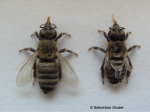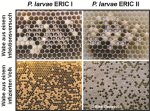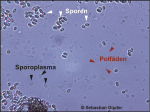General
Diseases of the bee are the main scientific interest of my department. In addition to the development of molecular methods for the diagnosis of infectious diseases of the honey bee, our research is focussed on three bee pathogens: the RNA virus called deformed wing virus (DWV), the Gram-positive bacteria Paenibacillus larvae and the microsporidia species Nosema apis and Nosema ceranae. All three pathogens are economically important as they cause significant European honey bee (Apis mellifera) losses — the third to fourth most important livestock in Germany. DWV leads to the death of infected pupae or hatched bees that are crippled and non-viable, especially when it is transmitted by the mite Varroa destructor. P. larvae causes the notifiable disease "American foulbrood" (AFB) that not only leads to the death of individual larvae but also the destruction of entire bee colonies. As intestinal parasites, Nosema apis and Nosema ceranae infest adult bees and cause diarrhoea and weaken infested colonies.
Our work currently focuses on the following topics:
We aim to understand the relationship between the viral pathogen DWV, the ectoparasitic mite Varroa destructor as a vector of DWV and the host (Apis mellifera) regarding the manifestation of a symptomatic and often fatal DWV infection in order to achieve a better control of varroasis. We are investigating the transmission paths and strategies of DWV in bee populations in order to prevent any further spread of virulent variants.
We aim to understand the molecular pathogenesis of Paenibacillus larvae infections and identify virulence factors and mechanisms of P. larvae in order to develop new control strategies. We are working on the development of various molecular epidemiological methods for P. larvae in order to improve control of AFB.
We are researching the epidemiology of Nosema apis and Nosema ceranae within the bee population of northeastern Germany in order to estimate the risks caused by Nosema ceranae. We aim to understand the cellular and molecular interactions, in particular between Nosema ceranae and Apis mellifera, in order to develop new treatment strategies.
The constant goal of our research is the development of new strategies for disease control and the minimisation of colony losses during the season and during winter by means of a better understanding of infectious diseases of honey bees.




